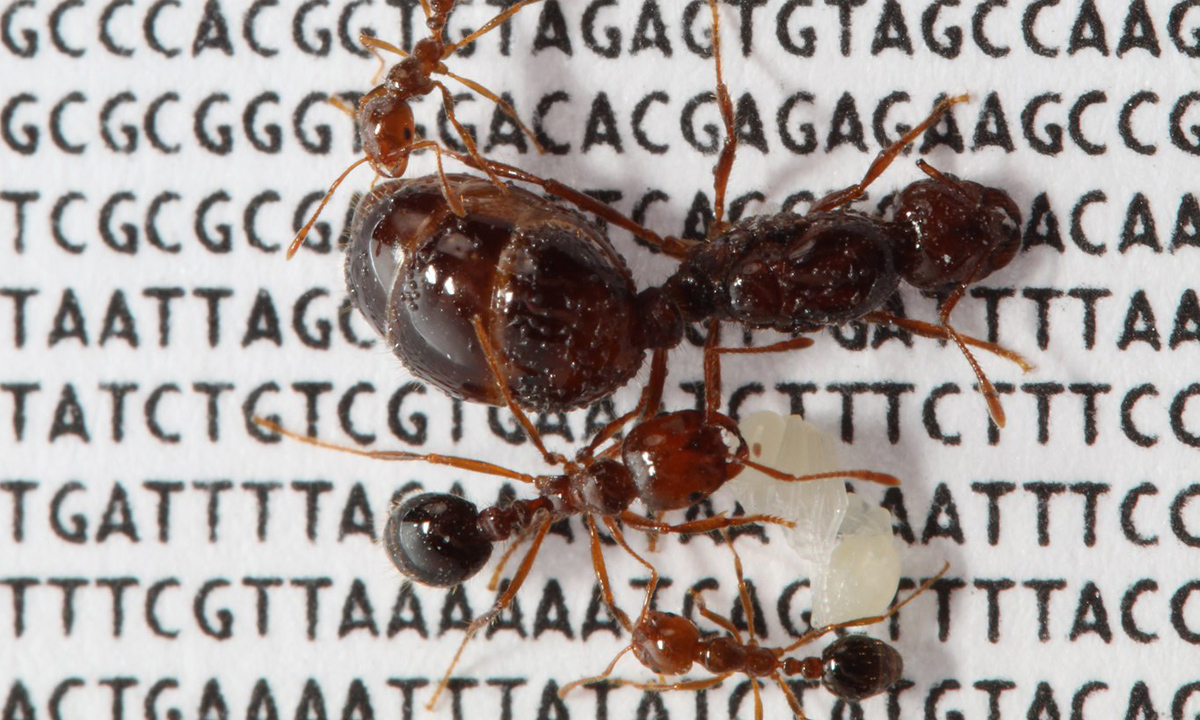New form of ant society spreads across species
 Solenopsis invicta fire ant queen with workers and a pupa. © Romain Libbrecht & Yannick Wurm
Solenopsis invicta fire ant queen with workers and a pupa. © Romain Libbrecht & Yannick Wurm
Cross-species spread of a new form of ant society in fire ants: A “social supergene” containing the genetic information for a new social organization evolved in one fire ant species and was passed on to other species. An international research team with Dr. Eckart Stolle from the LIB, Museum Koenig Bonn has now published these results. The alternative life form offers the ants an evolutionary advantage.
Red fire ants (Solenopsis invicta) originally had only colonies with one queen. About one million years ago, a new social form evolved where colonies could have dozens of queens. A particular version of a large section of chromosome, named the “social supergene”, includes the genetic information necessary to make workers accept more than one queen. The new research, published today in Nature Communications, analysed the entire genomes or instruction sets of 365 male fire ants to examine the evolution of the social supergene, and found that the same version of this chromosome is present in multiple fire ant species.
Transfer of large amounts of genetic information across species is rare because of genetic incompatibilities. However, in this case, the advantages of having multiple queens overrode the incompatibilities, and the genetic material repeatedly spread to other species from the one source species in which this new social form evolved. “The multiple-queen social form has advantages in several situations. For example, a multiple-queen colony has more workers and thus can outcompete a colony with only one queen. Furthermore, if there is a flood, a colony with multiple queens is less likely to become queenless”, explains Dr. Eckart Stolle, section leader of Comparative Insect Genomics at the LIB, Museum Koenig Bonn.
Dr. Yannick Wurm, Reader in Evolutionary Genomics and Bioinformatics at Queen Mary University of London and Fellow of the Alan Turing Institute, elaborates, “This research reveals how evolutionary innovations can spread across species. It also shows how evolution works at the level of DNA and chromosomes. It was incredibly surprising to discover that other species could acquire a new form of social organisation through hybridisation. The supergene region that creates multi-queen colonies is a large piece of chromosome that contains hundreds of genes. The many parts of a genome evolve to work together in fine-tuned manners, thus suddenly having a mix with different versions of many genes from another species is complicated and quite rare.”
Rodrigo Pracana, first author of the study together with Eckart Stolle, also from Queen Mary University of London, adds: ” Our study shows how detailed analysis of large numbers of wild animals can provide surprising new insight on how evolution works.”
Contact
Dr. Eckart Stolle
Head of Comparative Insect Genomics Section, LIB Museum Koenig Bonn
Tel. +49 228 9122-421
e.stolle@leibniz-lib.de


